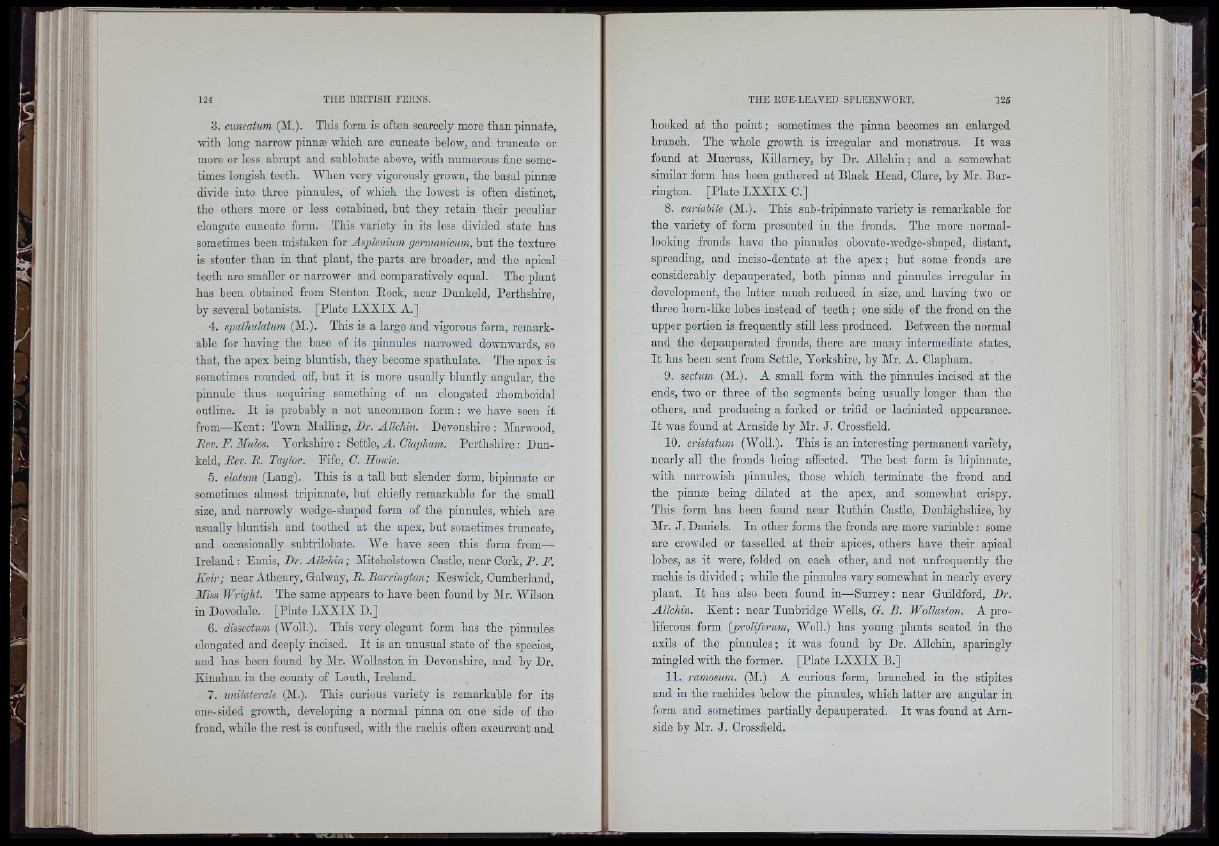
s
; i y
‘i
3. cuneatum (M.). This form is often scarcely more than pinnate,
with long narrow pinnæ which are cuneate below, and truncate or
more or less abrupt and sublobate above, with numerous fine sometimes
longish teeth. When very vigorously grown, the basal pinnæ
divide into three pinnules, of which the lowest is often distinct,
the others more or less combined, but they retain their peculiar
elongate cuneato form. This variety in its less divided state has
sometimes been mistaken for Asplenium germanicum, but the texture
is stouter than in that plant, the parts are broader, and the apical
teeth are smaller or narrower and comparatively equal. The plant
has been obtained from Stcnton Eook, near Dunkeld, Perthshire,
by several botanists. [Plate LXXIX A.]
4. spatliulatmn (M.). This is a large and vigorous form, remarkable
for having the base of its pinnules narrowed downwards, so
that, the apex being bluntish, they become spathulate. The apex is
sometimes rounded off, but it is more usually bluntly angular, the
pinnule thus acquiring sometliing of an elongated rhomhoidal
outline. It is probably a not uncommon form ; we have seen it
from—Kent ; Town Mailing, Br. AUchin. Devonshire : Marwood,
Rev. F. Mules. Yorkshire : Settle, A. Clapham. Perthshire : Dunkeld,
Rev. R. Taylor. Fife, C. Jlowie.
5. datum (Lang). This is a tail but slender form, bipinnate or
sometimes almost tripinnate, but chiefly remarkable for the small
size, and narrowly wedge-shaped form of the pinnules, which are
usually bluntish and toothed at the apex, but sometimes truncate,
and occasionally suhtrilobate. We have seen this form from—
Ireland : Ennis, Br. Allchin ; IMitchelstown Castle, near Cork, P. P.
Keir; near Athenry, Galway, R. Barrington; Keswick, Cumberland,
Miss Wright. The same appears to have been found by Mr. Wilson
in Dovedale. [Plate LXXIX D.]
6. dissectum (Well.). This very elegant form has the pinnules
elongated and deeply incised. It is an unusual state of the species,
and has been found by Mr. Wollaston in Devonshire, and by Dr.
Kinahan in the county of Louth, Ireland.
7. unilaterale (M.). This curious variety is remarkable for its
one-sided growth, developing a normal pinna on one side of tho
frond, while the rest is confused, with the raohis often excurrent and
hooked at the point ; sometimes the pinna becomes an enlarged
branch. The whole growth is irregular and monstrous. It was
found at Muoruss, KiUarney, by Dr. Allchin; and a somewhat
similar form has been gathered at Black Head, Clare, by Mr. Barrington.
[Plate LXXIX C.]
8. variabile (M.). Tbis sub-tripinnate variety is remarkable for
tbe variety of form presented in the fronds. The more normal-
looking fronds have the pinnules obovate-wedge-shapod, distant,
spreading, and inoiso-dentate at the apex; but some fronds are
considerably depauperated, both pinnæ and pinnules irregular in
development, the latter much reduced in size, and having two or
three horn-like lobes instead of teeth ; one side of the frond on the
upper portion is frequently still less produced. Between the normal
and the depauperated fronds, there are many intermediate states.
It has been sent from Settle, Yorkshire, by Mr. A. Clapham.
9. sectum (M.). A small form with the pinnules incised at the
ends, two or three of the segments being usually longer than the
others, and producing a forked or trifid or laoiniated appearance.
It was found at Arnside by Mr. J. Crossfield.
10. cristatum (WoU.). This is an interesting permanent variety,
nearly aU the fronds being affected. The best form is bipinnate,
with narrowish pinnules, those which terminate the frond and
the pinnæ being dilated at the apex, and somewhat crispy.
This form has been found near Euthin Castle, Denbighshire, by
Mr. J. Daniels. In other forms the fronds are more variable : some
are crowded or tasseUed at their apices, others have their apical
lobes, as it were, folded on each other, and not unfrequently the
raohis is divided ; whUe the pinnules vary somewhat in nearly every
plant. It has also been found in—Surrey : near Guildford, Br.
Allchin. Kent : near Tunbridge WeUs, O. B. Wollaston. A proliferous
form {proliferum, WoU.) has young plants seated in the
axils of the pinnules ; it was found by Dr. AUchin, sparingly
mingled with the former. [Plate LXXIX B.]
11. ramosum. (M.) A om-ious form, branched in the stipites
and in the rachides below the pinnules, which latter are angular in
form and sometimes partially depauperated. It was found at Am-
side by Mr. J. Crossfield.
ti!'’
■ '■ \
;l,l
-irl
ri ^-‘‘1
UM- il
j :
i '
k T l
(Ii.
■I?
m